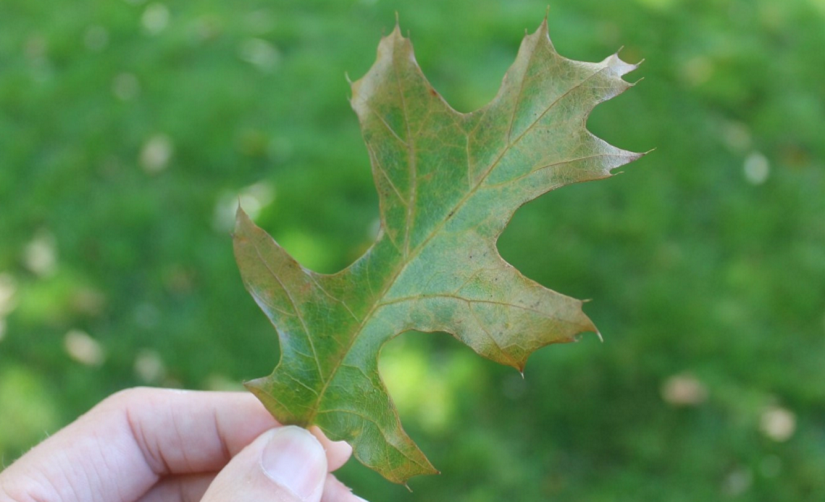Today’s post comes from Program Development Intern Vincent La Tassa at the Invasive Species Centre.
Ontario is home to a significant number of majestic oak trees, many of which take root in our provincial parks.
They provide us with shade, beauty, and a sense of connection with nature. The sprawling canopies of these mighty oaks offer a serene backdrop to our adventures.
However, there is a silent threat to oak trees.
Read on so we can work together to prevent it from spreading:
What is oak wilt?
Oak wilt is named after the hallmark leaf “wilting” and discolouring of infected oak trees.
It is a disease caused by an invasive fungus, Bretziella fagacearum, that infects oaks by entering fresh wounds on the tree.

Once a tree has been infected, the fungus grows throughout the outer sapwood, which is the part of the tree just underneath the bark that transports water and nutrients from the roots to the leaves.
As it spreads, the fungus blocks the flow of these resources, eventually killing the tree.

After the tree has died, the fungus forms areas where spores are released, known as “sporulating mats” or “pressure pads.” These mats release a sweet “juicy fruit”-like smell that attracts native sap beetles.
As the beetles feed on the fungal mats, spores stick to their bodies and can be transported by the beetle to the wounds of nearby healthy trees, beginning the process of infection all over.

The disease can also spread underground to neighbouring healthy oak trees of the same species through their connected roots.
While all species of oak trees are susceptible to oak wilt, Red Oaks are the most severely affected and can die within a single season.
Recognizing the signs and symptoms
Being vigilant is the first step in preventing the spread of oak wilt.
When hiking along trails, picking out the perfect spot to pitch your tent, or simply enjoying the views, keep an eye out for:
- wilted or bronzed leaves beginning from the top of the oak tree and moving downward
- discoloured leaves starting from the outer edges and moving inwards to the centre midrib
- sudden and early leaf drop resulting in complete defoliation
- vertical cracks in tree bark from the outward growth of the “pressure pad” underneath
- white, grey, or black “staining” (from the fungal mat) underneath tree bark, along with a fruity smell similar to juicy fruit gum
- fallen branches showing dark rings or blotches in their cross-section, known as “vascular streaking”

Don’t get confused!
Not all oak trees with discoloured leaves are infected with oak wilt.

Leaves can also be discoloured from natural conditions like leaf scorch, resulting from factors such as high temperatures and low moisture.
What YOU can do to protect our oaks?
- Don’t move firewood! It could contain live oak wilt fungal spores under the bark. Always burn firewood where you buy it. Kiln-dried firewood is available for purchase at operating parks
- Don’t prune or damage oak trees on your own property between April and October, as this is the most likely period for fungal spores spread by sap beetles. If pruning must occur, paint a thin layer of wound paint or shellac on the wound immediately. Wounds caused by storms or other events should also be painted immediately
- Learn how to identify the signs and symptoms of oak wilt
- Report sightings of oak wilt to the Canadian Food Inspection Agency (CFIA) immediately, and tell park staff if you see signs in a provincial park!
- Spread the word! Share your knowledge on the threat of oak wilt with other campers while roasting marshmallows over the campfire (with firewood purchased on-site, of course!)
- Visit the Invasive Species Centre’s website to learn more about oak wilt and how you can help. While you’re there, check out our oak wilt course offered through our training program! Upon completion, you’ll receive a certificate of completion to show off your oak wilt knowledge

Let’s all do our part!
Our connection with oaks is an integral part of our outdoor experience.
By understanding the threat of oak wilt and adopting preventive measures, we can ensure that these magnificent trees continue to thrive, providing shade and beauty for generations to come.
Let’s unite in our commitment to preserving the natural wonders of provincial parks and outdoor spaces.
Oak trees live in many Ontario Parks. In parks such as Pinery Provincial Park, which is home to seven species of oak tree, park staff have modified their tree trimming work to adhere to the recommendations above.
Staff are also monitoring trees for signs of Oak Wilt infection, but they need your help! If you see an oak in a park that shows signs of infection, please notify park staff and the Canadian Food Inspection Agency (CFIA).
